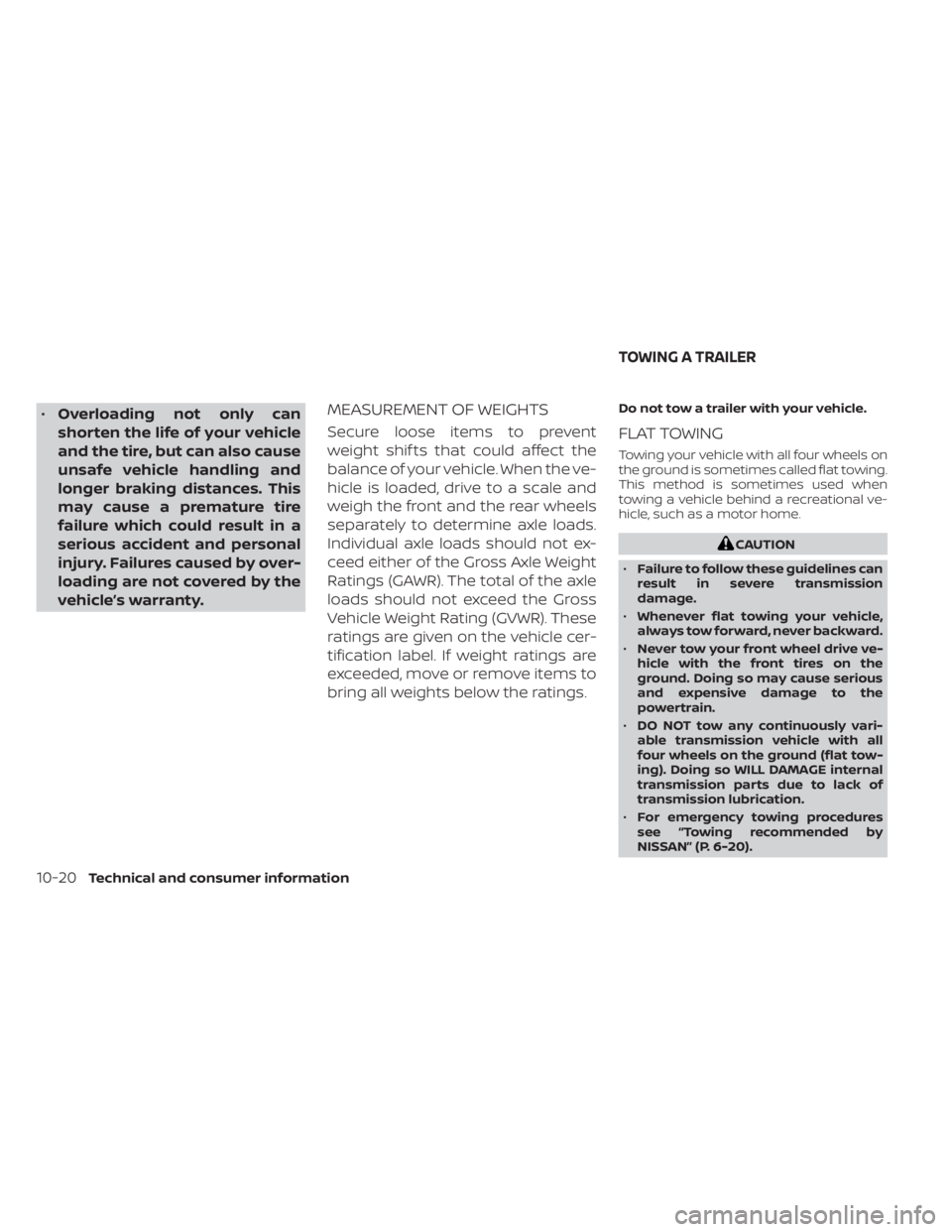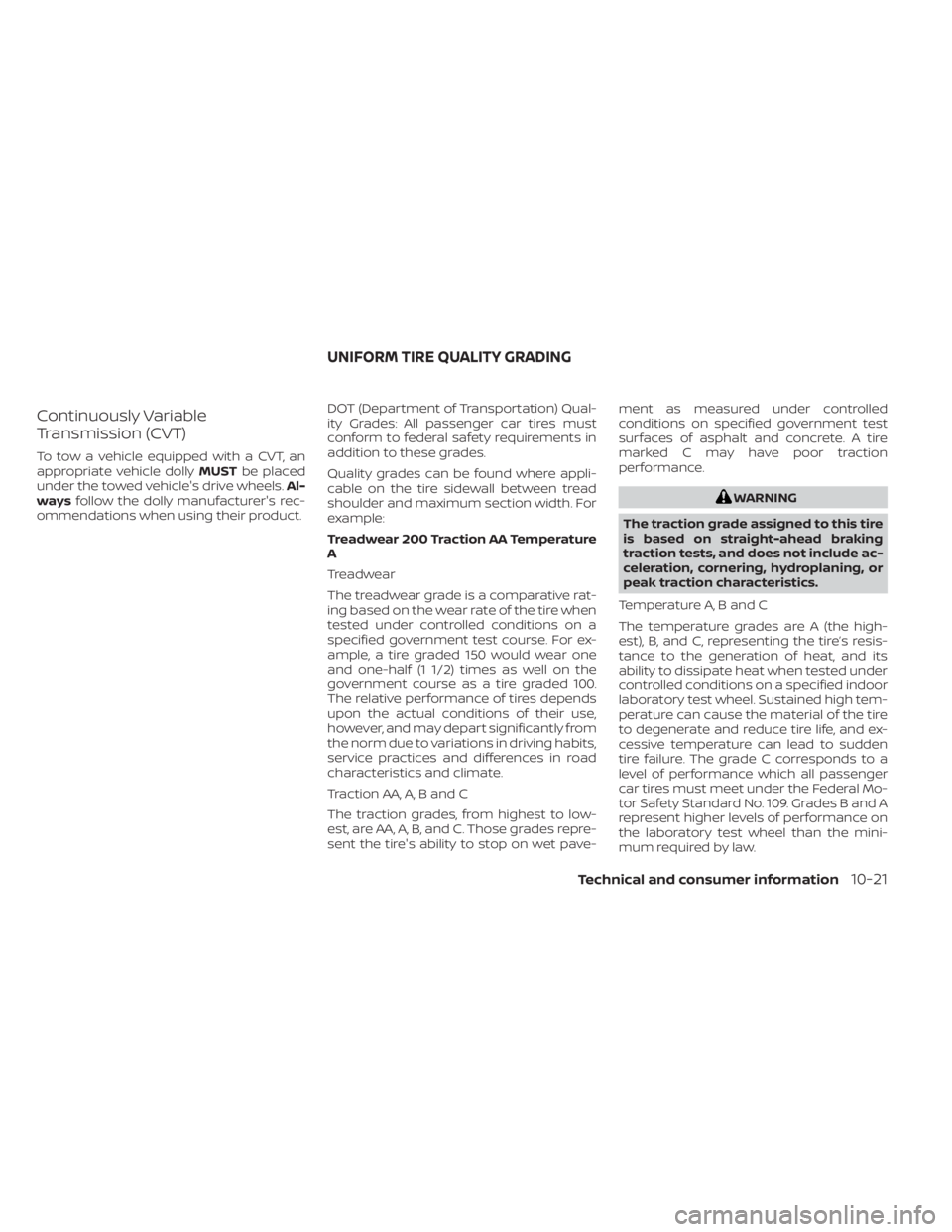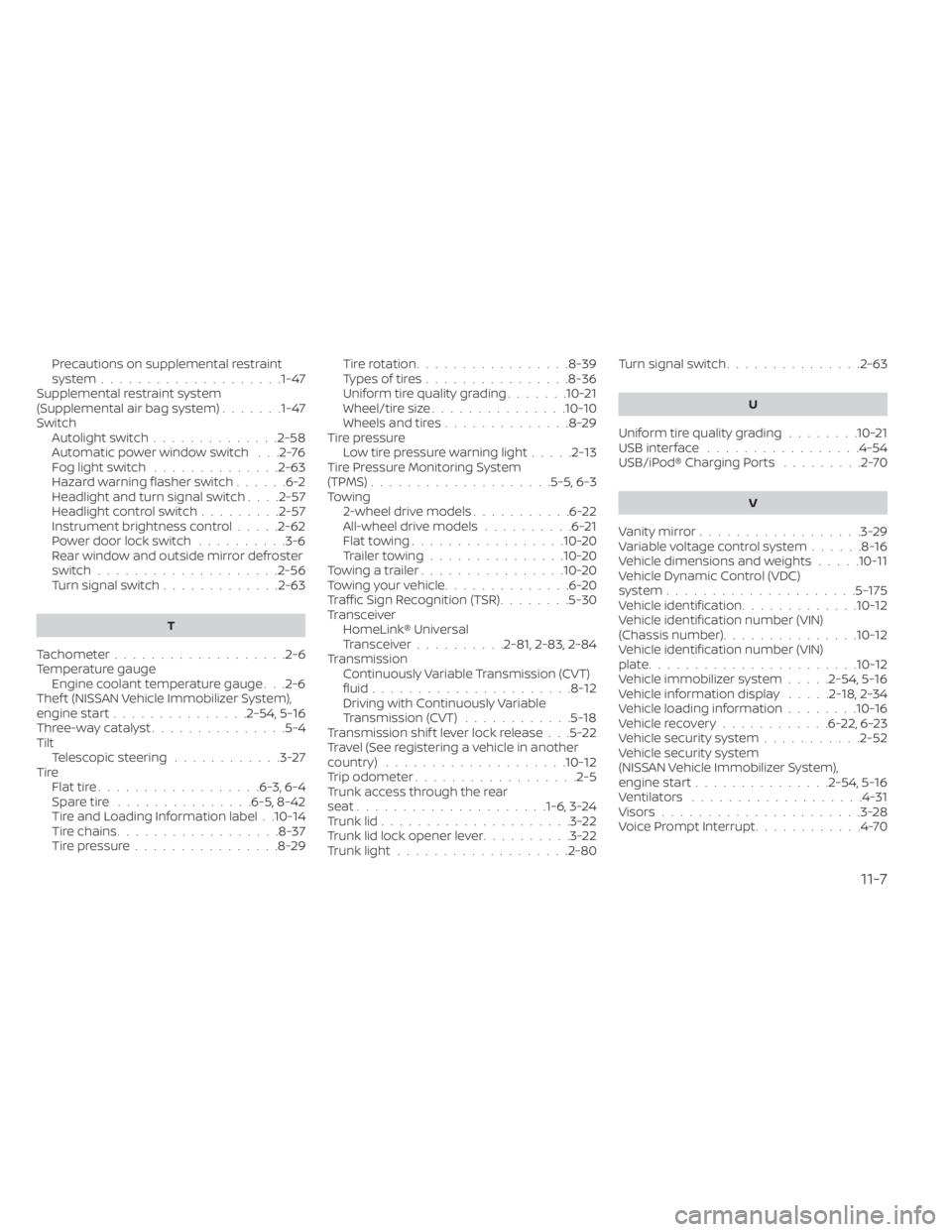Page 620 of 644

•Overloading not only can
shorten the life of your vehicle
and the tire, but can also cause
unsafe vehicle handling and
longer braking distances. This
may cause a premature tire
failure which could result in a
serious accident and personal
injury. Failures caused by over-
loading are not covered by the
vehicle’s warranty.MEASUREMENT OF WEIGHTS
Secure loose items to prevent
weight shif ts that could affect the
balance of your vehicle. When the ve-
hicle is loaded, drive to a scale and
weigh the front and the rear wheels
separately to determine axle loads.
Individual axle loads should not ex-
ceed either of the Gross Axle Weight
Ratings (GAWR). The total of the axle
loads should not exceed the Gross
Vehicle Weight Rating (GVWR). These
ratings are given on the vehicle cer-
tification label. If weight ratings are
exceeded, move or remove items to
bring all weights below the ratings.
Do not tow a trailer with your vehicle.
FLAT TOWING
Towing your vehicle with all four wheels on
the ground is sometimes called flat towing.
This method is sometimes used when
towing a vehicle behind a recreational ve-
hicle, such as a motor home.
CAUTION
• Failure to follow these guidelines can
result in severe transmission
damage.
• Whenever flat towing your vehicle,
always tow forward, never backward.
• Never tow your front wheel drive ve-
hicle with the front tires on the
ground. Doing so may cause serious
and expensive damage to the
powertrain.
• DO NOT tow any continuously vari-
able transmission vehicle with all
four wheels on the ground (flat tow-
ing). Doing so WILL DAMAGE internal
transmission parts due to lack of
transmission lubrication.
• For emergency towing procedures
see “Towing recommended by
NISSAN” (P. 6-20).
TOWING A TRAILER
10-20Technical and consumer information
Page 621 of 644

Continuously Variable
Transmission (CVT)
To tow a vehicle equipped with a CVT, an
appropriate vehicle dollyMUSTbe placed
under the towed vehicle's drive wheels. Al-
ways follow the dolly manufacturer's rec-
ommendations when using their product. DOT (Department of Transportation) Qual-
ity Grades: All passenger car tires must
conform to federal safety requirements in
addition to these grades.
Quality grades can be found where appli-
cable on the tire sidewall between tread
shoulder and maximum section width. For
example:
Treadwear 200 Traction AA Temperature
A
Treadwear
The treadwear grade is a comparative rat-
ing based on the wear rate of the tire when
tested under controlled conditions on a
specified government test course. For ex-
ample, a tire graded 150 would wear one
and one-half (1 1/2) times as well on the
government course as a tire graded 100.
The relative performance of tires depends
upon the actual conditions of their use,
however, and may depart significantly from
the norm due to variations in driving habits,
service practices and differences in road
characteristics and climate.
Traction AA, A, B and C
The traction grades, from highest to low-
est, are AA, A, B, and C. Those grades repre-
sent the tire's ability to stop on wet pave-ment as measured under controlled
conditions on specified government test
surfaces of asphalt and concrete. A tire
marked C may have poor traction
performance.
WARNING
The traction grade assigned to this tire
is based on straight-ahead braking
traction tests, and does not include ac-
celeration, cornering, hydroplaning, or
peak traction characteristics.
Temperature A, B and C
The temperature grades are A (the high-
est), B, and C, representing the tire’s resis-
tance to the generation of heat, and its
ability to dissipate heat when tested under
controlled conditions on a specified indoor
laboratory test wheel. Sustained high tem-
perature can cause the material of the tire
to degenerate and reduce tire life, and ex-
cessive temperature can lead to sudden
tire failure. The grade C corresponds to a
level of performance which all passenger
car tires must meet under the Federal Mo-
tor Safety Standard No. 109. Grades B and A
represent higher levels of performance on
the laboratory test wheel than the mini-
mum required by law.
UNIFORM TIRE QUALITY GRADING
Technical and consumer information10-21
Page 633 of 644

Precautions on supplemental restraint
system....................1-47Supplemental restraint system
(Supplemental air bag system).......1-47Switch
Autolight switch..............2-58Automatic power window switch. . .2-76Fog light switch..............2-63Hazard warning flasher switch......6-2Headlight and turn signal switch. . . .2-57Headlight control switch.........2-57Instrument brightness control.....2-62Power door lock switch..........3-6Rear window and outside mirror defroster
switch................... .2-56Turn signal switch.............2-63
T
Tachometer...................2-6Temperature gauge
Engine coolant temperature gauge. . .2-6Thef t (NISSAN Vehicle Immobilizer System),
engine start...............2-54, 5-16Three-way catalyst...............5-4TiltTelescopic steering............3-27TireFlat tire................. .6-3, 6-4Spare tire...............6-5, 8-42Tire and Loading Information label. .10-14Tire chains..................8-37Tire pressure................8-29
Tire rotation.................8-39Types of tires................8-36Uniform tire quality grading.......10-21Wheel/tire size...............10-10Wheels and tires..............8-29Tire pressure
Low tire pressure warning light.....2-13Tire Pressure Monitoring System
(TPMS)................... .5-5, 6-3Towing
2-wheel drive models...........6-22All-wheel drive models..........6-21Flat towing................ .10-20Trailer towing...............10-20Towing a trailer................10-20Towing your vehicle..............6-20Traffic Sign Recognition (TSR)........5-30Transceiver
HomeLink® Universal
Transceiver
..........2-81, 2-83, 2-84TransmissionContinuously Variable Transmission (CVT)
fluid
......................8-12Driving with Continuously Variable
Transmission (CVT)............5-18Transmission shif t lever lock release. . .5-22Travel (See registering a vehicle in another
country)................... .10-12Trip odometer..................2-5Trunk access through the rear
seat.................... .1-6, 3-24Trunk lid.....................3-22Trunk lid lock opener lever..........3-22Trunk light...................2-80
Turn signal switch...............2-63
U
Uniform tire quality grading........10-21USB interface.................4-54USB/iPod® Charging Ports.........2-70
V
Vanity mirror..................3-29Variable voltage control system......8-16Vehicle dimensions and weights.....10-11Vehicle Dynamic Control (VDC)
system.....................5-175Vehicle identification.............10-12Vehicle identification number (VIN)
(Chassis number)...............10-12Vehicle identification number (VIN)
plate...................... .10-12Vehicle immobilizer system.....2-54, 5-16Vehicle information display.....2-18,2-34Vehicle loading information........10-16Vehicle recovery............6-22,6-23Vehicle security system...........2-52Vehicle security system
(NISSAN Vehicle Immobilizer System),
engine start
...............2-54, 5-16Ventilators.................. .4-31Visors......................3-28Voice Prompt Interrupt............4-70
11-7